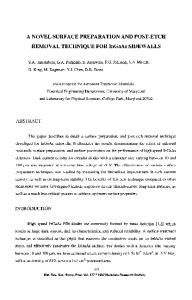A novel surface modification technique for aluminum
- PDF / 1,076,766 Bytes
- 4 Pages / 612 x 828 pts Page_size
- 31 Downloads / 384 Views
Surface modification is achieved by coating the aluminum surface with a powder mix of {Si + flux + a metal (Me)} and heating at —600 °C for a time interval of the order of 1 min. During heating, the flux melts and dissolves the native surface oxide film on aluminum, thus allowing Si to react with the substrate to form a film of liquid Al-Si alloy of near-eutectic composition. The component Me of the powder coating then reacts with the molten metal layer to modify the metallurgical properties of the surface after solidification.
In previous publications1 3 the authors described a simple technique for generating liquid filler metal on the surface of aluminum alloys to enable the surface to be brazed. In that technique, the aluminum surface is coated with a powder mix consisting of Si and a flux,1 and is then heated in nitrogen gas to —600 °C. During heating, the flux melts at ~562 °C and dissolves A12O3 surface layers.4 This allows the Si particles to come into intimate contact with the bare metal and to dissolve rapidly into the aluminum surface when the temperature exceeds the Al-Si eutectic reaction temperature of 577 °C. This dissolution leads to the in situ generation of a layer of Al-Si liquid-alloy of near-eutectic composition at a temperature appreciably lower than the melting point of the substrate (660 °C). The quantity of aluminum converted to liquid is directly proportional to the Si surface coverage. The present surface modification technique takes advantage of the liquid metal formation mechanism described above and occurs as follows. The aluminum surface is coated with a powder mix consisting of Si, a flux (mentioned above), and a selected metal (Me) as illustrated in Fig. l(a). The surface is then heated at —600 °C for a time interval of 1-5 min in nitrogen gas. As explained previously, the flux melts during heating and removes surface oxide films as illustrated in Fig. l(b), thus allowing Si dissolution and the ensuing formation of a layer of Al-Si liquid1"3 when the temperature exceeds 577 °C [Fig. l(c)]. Experimentally, it is found that the presence of Me in the powder mix does not interfere noticeably with the oxide removal and Si dissolution mechanisms. It is also found that Me powder reacts with the liquid Al-Si metal to yield, on solidification, a surface layer of chemical composition and metallurgical structure vastly different from those of the base material, as illustrated in Fig. l(d). This difference stems from one or several of the following mechanisms: (i) entrapment of Me particles in the solidified Al-Si alloy layer, (ii) dissolution of Me particles in the Al-Si J. Mater. Res., Vol. 9, No. 3, Mar 1994
http://journals.cambridge.org
Downloaded: 24 Mar 2015
liquid, and (iii) reaction of Me with the Al-Si liquid to form intermetallic compounds. In the present work, surface modification was carried out on coupons of AA1100 aluminum alloy [composition: (Si + Fe) 0.95, Cu 0.05-0.2, Mn 0.05, Zn 0.1 wt. %, balance Al]. The coupons were 75 mm X 25 mm X 1 mm in dimension. Each coupon was clea
Data Loading...











